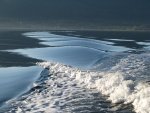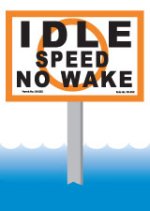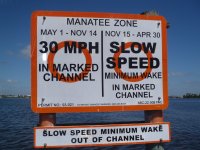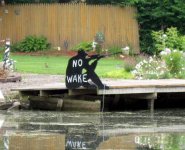smittypaddler
New member
- Joined
- Jun 30, 2004
- Messages
- 337
- Reaction score
- 0
- C Dory Year
- 2004
- C Dory Model
- 22 Cruiser
- Hull Identification Number
- CD022206D404
- Vessel Name
- Na Waqa
I'm at Acosta Creek Harbor on the St Johns, having arrived Tuesday after the long 1380-mile trip from Wisconsin. As I was walking down the pier to my slip the other day I saw with delight two C-Dorys coming upriver from the north. I wondered if they were stopping here, but they both kept up on plane, and passed the half-dozen large "No Wake Please" signs facing the river.
Their wakes weren't the worst I've experienced here at Acosta Creek. There's a club in Jacksonville of owners of beautifully renovated antique Chris Craft inboards that often do group cruises up the St Johns. An armada of 20 of those heavy old boats passing by up on plane causes a maelstrom here in the marina. They caught me one year frying bacon, and I had a choice between balancing the frying pan full of grease, and catching the cup of hot coffee on the table behind me. The spilled coffee only caused a brief redness on my backside.
There was a fellow living here at Acosta Creek Harbor on a houseboat, wheelchair bound, with only one arm that worked. They'd built him a ramp from his houseboat to the pier so he could get to his wheelchair up on the pier. He'd maneuver his way from the boat up onto the pier using that one good arm and what little strength he had in his legs. I wondered what would happen to him if he were in that slow process when the inboards went by.
A sailing friend of mine described to me being anchored and rafted up with several other sailboats just outside the channel and offshore from the official no-wake buoys in a channel leading into a harbor on Green Bay in Wisconsin. A big 42-foot powerboat came snowplowing into the channel as my friend desperately waved his arms, trying to get the guy to give them a brake. Instead, the powerboat driver (I won't call him captain) merely pointed at the official no-wake buoys, and kept on snowplowing. One of the cleats on his boat got pulled clean out when the wake hit them.
In my own case, I try not to have a rigid schedule (the most dangerous thing on a boat) and I'm just out there recreating, so although it sometimes irks me when I see boats tied directly broadside to a riprap shore, relying on me to take care (self-preservation is a word in the dictionary, just like courtesy), I try to always take the few seconds or minutes to come off plane. But the motivation is also the guilt I feel for the few times over the years I, for whatever reason, failed to be courteous.
I started this thread, because I keep wondering if I'm missing something. Am I priding myself on being a courteous waterman when there's a good reason so many folks don't slow down when passing an unofficial "No Wake Please" sign? Am I being like the Bambi lovers who want to ban deer hunting, not recognizing that if they got their way Bambi would eventually starve due to an unchecked deer herd population? For those of you who don't slow down when they see a "No Wake Please" sign, what's your reasoning?
Their wakes weren't the worst I've experienced here at Acosta Creek. There's a club in Jacksonville of owners of beautifully renovated antique Chris Craft inboards that often do group cruises up the St Johns. An armada of 20 of those heavy old boats passing by up on plane causes a maelstrom here in the marina. They caught me one year frying bacon, and I had a choice between balancing the frying pan full of grease, and catching the cup of hot coffee on the table behind me. The spilled coffee only caused a brief redness on my backside.
There was a fellow living here at Acosta Creek Harbor on a houseboat, wheelchair bound, with only one arm that worked. They'd built him a ramp from his houseboat to the pier so he could get to his wheelchair up on the pier. He'd maneuver his way from the boat up onto the pier using that one good arm and what little strength he had in his legs. I wondered what would happen to him if he were in that slow process when the inboards went by.
A sailing friend of mine described to me being anchored and rafted up with several other sailboats just outside the channel and offshore from the official no-wake buoys in a channel leading into a harbor on Green Bay in Wisconsin. A big 42-foot powerboat came snowplowing into the channel as my friend desperately waved his arms, trying to get the guy to give them a brake. Instead, the powerboat driver (I won't call him captain) merely pointed at the official no-wake buoys, and kept on snowplowing. One of the cleats on his boat got pulled clean out when the wake hit them.
In my own case, I try not to have a rigid schedule (the most dangerous thing on a boat) and I'm just out there recreating, so although it sometimes irks me when I see boats tied directly broadside to a riprap shore, relying on me to take care (self-preservation is a word in the dictionary, just like courtesy), I try to always take the few seconds or minutes to come off plane. But the motivation is also the guilt I feel for the few times over the years I, for whatever reason, failed to be courteous.
I started this thread, because I keep wondering if I'm missing something. Am I priding myself on being a courteous waterman when there's a good reason so many folks don't slow down when passing an unofficial "No Wake Please" sign? Am I being like the Bambi lovers who want to ban deer hunting, not recognizing that if they got their way Bambi would eventually starve due to an unchecked deer herd population? For those of you who don't slow down when they see a "No Wake Please" sign, what's your reasoning?




